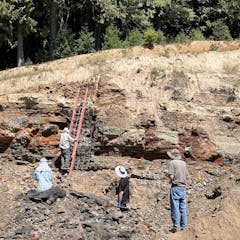
Articles on Biomarkers
Displaying 1 - 20 of 37 articles

Identifying proteins that are only present in bodily fluids when a patient has breast cancer could provide a way to screen healthy people for the disease.

While NASA rovers on the surface of Mars look for hints of life, researchers back on Earth are studying ‘echoes of life’ from ancient basins – hoping that the two sites might be similar.

Your blood contains a wealth of information about the state of your health. Analyzing the levels of each component is an important part of diagnosis.

The NHS will trial a new blood test for dementia, which could be widely available in five years.

Blood isn’t sterile, and analyzing the bacteria in it could help assess the health of fish and prevent the collapse of their populations.

Why we should all try to be biologically younger.

Centenarians tend to have lower levels of glucose, creatinine and uric acid from their sixties onwards.

Pain has long been subjectively measured, leading to frustrations for patients and doctors alike. Identifying neural biomarkers of pain could improve diagnosis and lead to better treatments of chronic pain conditions.

Aging is a major risk factor for many chronic diseases. Figuring out what influences longevity and how to identify rapid agers could lead to healthier and longer lives for more people.

People don’t all age at the same rate. Untangling the factors that influence health and disease – such as epigenetics, demographics and behavior – could lead to better care for those who need it most.

Our study found that low levels of INSL3 hormone were associated with greater risk of cardiovascular disease, diabetes and frailty in men.

Chemicals are omnipresent in our lives and production is booming, yet we know little about their impacts on human health. To fill the gap, the EU has launched a series of biomonitoring initiatives.

Exposure to hot and dry conditions can damage the DNA of nestling birds in their first few days of life – meaning they age earlier and produce less offspring.

Many doctors currently diagnose skin conditions by eye. Advances in molecular testing could lead to more precise and accurate diagnoses for ambiguous rashes and skin lesions.

A new study shows connections between genetics, biomarkers in the blood, and mental disorders - opening new avenues to understand the causes of mental illness and find new treatments.

Dogs have such sensitive noses that they can be trained to detect the odors of crop pests, endangered species, illegal drugs – and diseases like COVID-19.

Fat cells and cancer cells talk to each other. Specialists in both systems can do the same.

A growing body of research shows that nutrition, sleep, exercise and a host of other lifestyle choices can help optimize the immune system. But they are no substitute for life-saving vaccines.

DNA testing for cocoa beans could fight slavery and child labour.

A study of 800 Black American families shows early experiences of racism have long-term consequences for physical and mental health.

